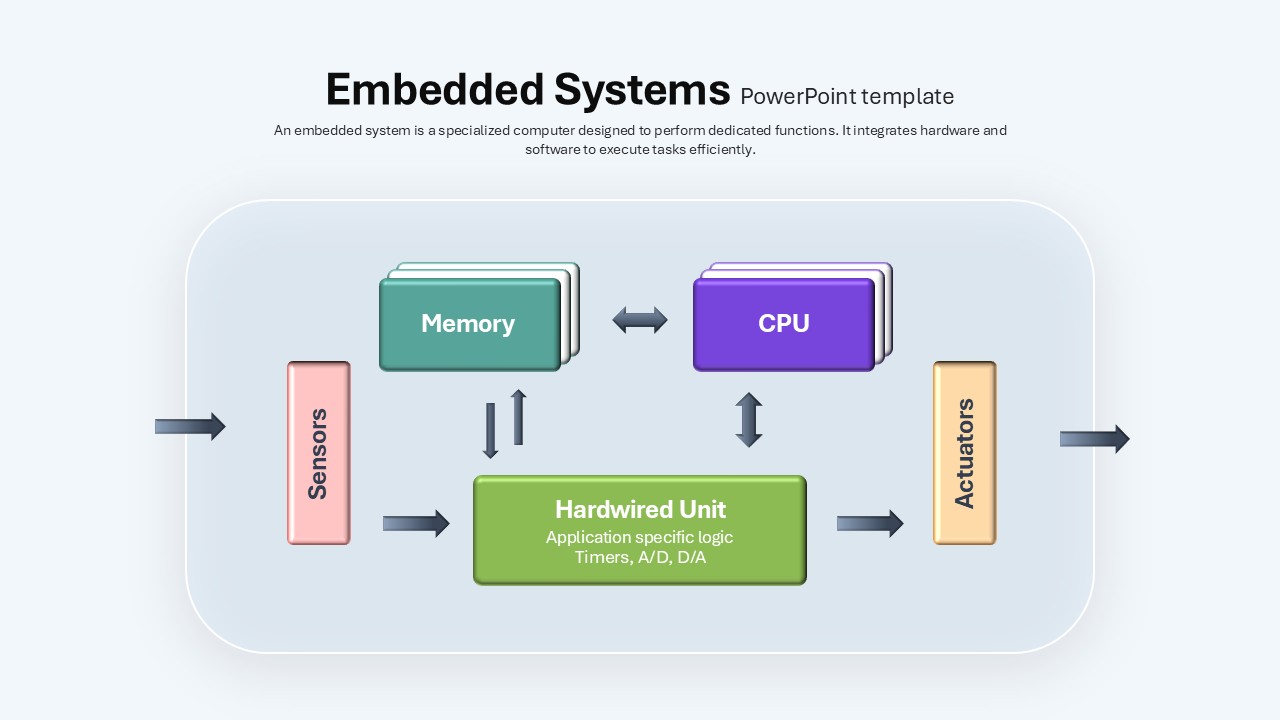Embedded Systems PowerPoint Template

Description
Present complex embedded systems architecture with clarity using this dark-themed slide. Centralized within a sleek navy backdrop, the rounded-corner container highlights five modular blocks—Sensors, Hardwired Unit, Memory, CPU, and Actuators—connected by intuitive arrows to depict data flow and control pathways. Each element uses contrasting pastel and jewel-toned shapes for immediate visual distinction: pale pink for sensor inputs, lime green for application-specific logic units, teal and violet stacks for memory and processing cores, and soft amber for output actuators. Crisp typography and subtle drop shadows ensure readability against the dark gradient background, while master slide integration and editable placeholders let you customize labels, adjust colors, and reposition icons in seconds. Optimized for both PowerPoint and Google Slides, this template maintains full-resolution clarity across devices and preserves slide masters, eliminating formatting issues and version-control headaches.
Engineered to accelerate technical presentations, the slide supports drag-and-drop icons, auto-aligned connectors, and responsive layout grids that adapt seamlessly as you add or remove components. Whether illustrating sensor data capture, control logic operations, memory hierarchy, or actuator-driven responses, the modular design scales to include additional units or interconnections without compromising visual balance. Predefined text fields and section markers simplify content updates, while uniform styling ensures brand consistency across multiple slides.
Beyond core embedded systems courses and hardware overview sessions, this asset lends itself to broader use cases—from IoT architecture diagrams, robotics control flow presentations, and automotive ECU breakdowns to industrial automation workflows and system-on-chip (SoC) design reviews. Duplicate the base layout to create multi-slide modules, highlight communication protocols, or compare alternative hardware configurations with minimal effort.
Who is it for
Embedded systems engineers, hardware designers, IoT specialists, and technical instructors will find this diagram indispensable for conveying system components and interactions. University lecturers, research teams, and product managers can leverage its clear, modular design to streamline complex technical briefings.
Other Uses
Repurpose this slide for robotics workflow overviews, automotive control unit training, industrial automation schematics, system-on-chip planning, or electronics prototyping sessions. Use the modular blocks to map custom hardware interfaces, compare sensor arrays, or visualize control logic across diverse engineering domains.
Login to download this file
Add to favorites
Add to collection

















































